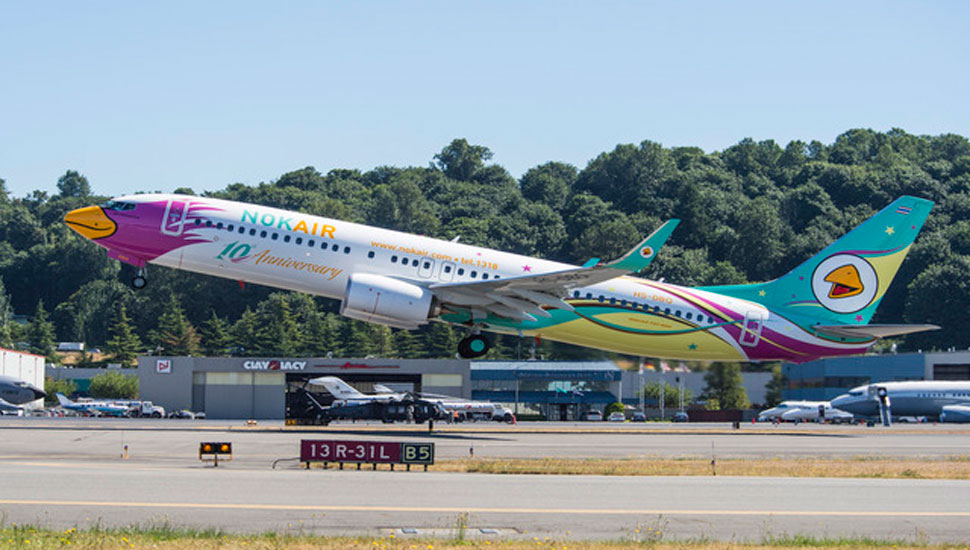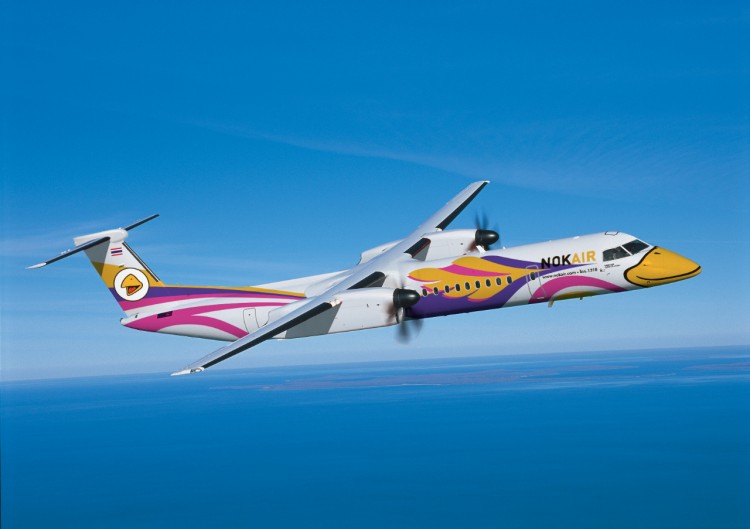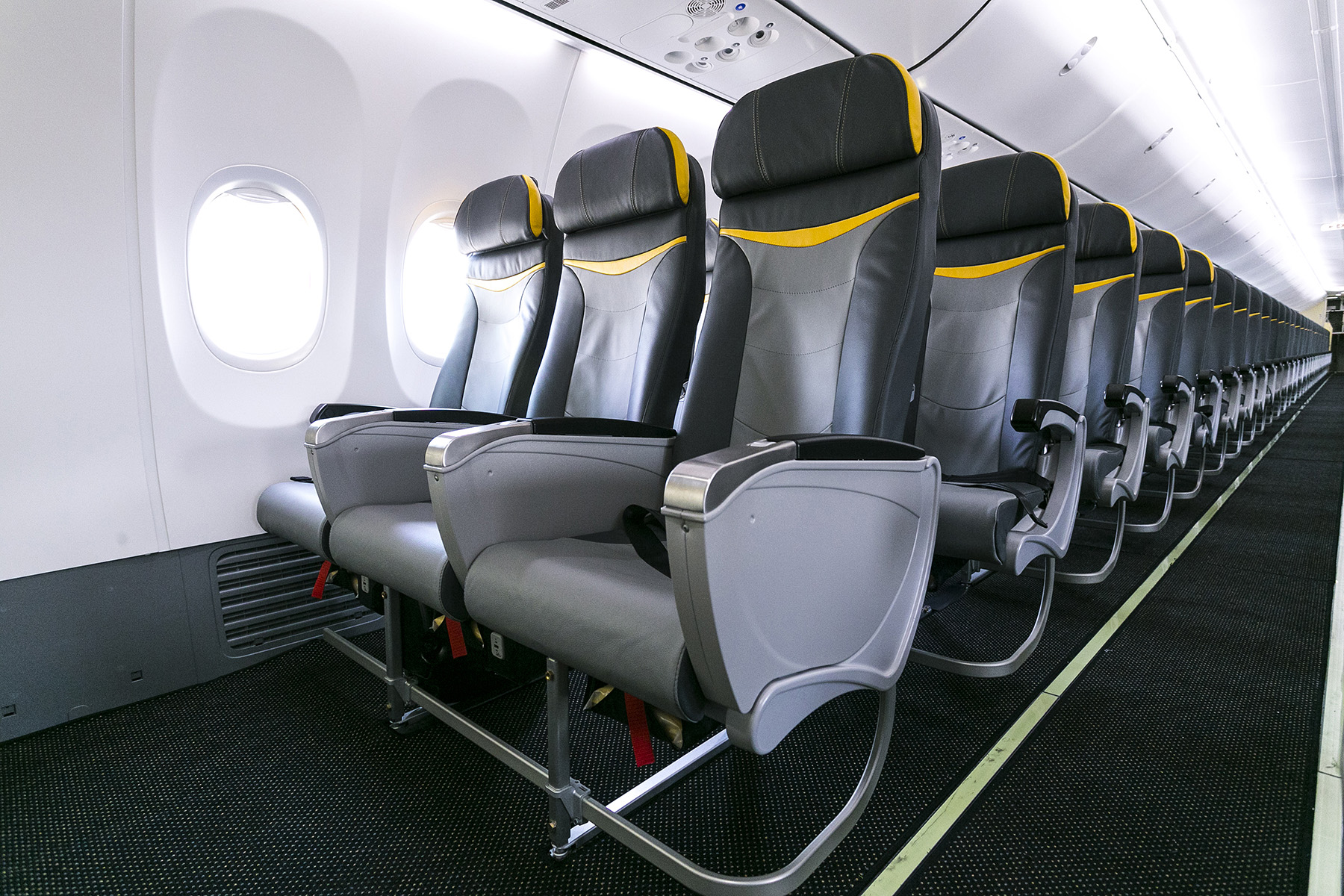EXCLUSIVE INTERVIEW: Rehabilitation Gives A New Lease Of Life To Nok Air
Note: Thai language version of article is lower down หมายเหตุ: บทความภาษาไทยอยู่ด้านล่าง
Thai budget carrier Nok Air looks set to rise like a phoenix from the ashes as its rehabilitation is gaining traction amidst challenges.
This comes one month after the kingdom’s Central Bankruptcy Court gave a final green light for the beleaguered airline’s five-year revival plan to move full steam ahead.
Nok Air, founded in 2004, has also secured agreements with nearly all of its 400 creditors including 12 aircraft lessors to restructure 5.13 billion baht (US$154.88 million) in outstanding debts.
The airline expects to finalise talks for new deals with the 10% remaining creditors, including a couple of lessors, over the next fortnight.
“It’s fair to say that we have reached a breakthrough in the negotiations that are no longer a stumbling block for our recovery going forwards,” Nok Air CEO, Wutthiphum Jurangkool, tells Smart Aviation Asia Pacific.
The airline, which filed for bankruptcy protection July last year, has charted a new course for revival that incorporates major transformations, including to its business model, that are expected to turn its balance sheet around as early as the end of next year.
Wutthiphum says they plan to move from being a low-cost carrier (LCC) into the ‘premium’ sphere because the low-cost segment is characterised by fierce fare competition and tight margins.
Stop bleeding
“We believe we can stop bleeding next year, achieving a breakeven point by the fourth quarter and becoming profitable in the following years,” says the 42-year-old executive, who is one of the four administrators of the rehabilitation plan.
Based on a conservative projection, Nok Air expects its annual revenue to rebound to the pre-COVID level, of around 20 billion baht (US$600 million), in 2026, or at end of the five-year recovery scheme, if not sooner.
Financial troubles at Nok Air were evident before the COVID outbreak with losses amounting to 1.85 billion in 2017 and 2.78 billion baht in 2018.
The emergence of the pandemic in Thailand early in 2020 started to take its toll on the carrier as stringent government measures locked down the country and repeatedly grounded domestic air services.
The airline lost to a record eight billion baht in 2020, from 2.1 billion baht in 2019.
Nok Air has not reported 2021’s first half-financial results to the Stock Exchange of Thailand.
Capital injection
Nok will need to secure five billion baht in fresh capital to see through its five-year rehabilitation, says Wutthiphum.
The new capital injection will come in three periods: 230 million baht in 2022, 600 million baht in 2023 and about four billion baht in the subsequent years, he says.
The new capital, the bulk of which will go towards aircraft acquisition, is expected come from the present and new shareholders, and financial institutions, says Wutthiphum, whose family owns 75% of Nok Air.
He says Nok has no liquidity issues, for the time being, and can sustain its operations, thanks to a 2.3 billion baht capital injection secured at the end of 2019 as well as three billion baht in bank credit lines.
This explains why the airline has no need to boost its capital this year, he says, adding that the new capital needs to be sought starting next year to increase liquidity and for placing deposits for new aircraft.
Fleet rejigging
Rearranging its fleet, which now consists of 14 Boeing 737-800s and eight Bombardier Dash 8-400 turboprops, features prominently in Nok Air’s recovery plan.

Wutthiphum says the airline has signed agreements with lessors for six Boeing 737-800s to join its fleet starting early next year.
He says the acquisition of these aircraft forms part of the rehabilitation plan.
Wutthiphum also says contracts with the creditor lessors have been amended and that the lessors have agreed to leases based on actual hour use, rather than a fixed rate per month, thus turning the lease from a fixed to a variable cost.
Under the new plan, the Dash 8-400 fleet will reduce to three aircraft from eight with the remainder returned to lessors by the end of this year.
But Wutthiphum adds that the return of the Dash 8-400s, which involve high lease and maintenance costs, is subject to negotiations with the lessors.
He says three Dash 8-400s are sufficient for Nok Air’s secondary domestic route services to cities with short runways like Mae Sod, Phrae and Lampang.

Nok Air has been talking to Boeing about converting its order for seven 737 Max aircraft, that it ordered in 2014, into an order for the next version of the narrow-body jet that could be rolled out down the road. Boeing, which only recently started delivery of MAX aircraft to airlines following a long hiatus, has made no mention of whether it will develop a new version of the 737 or develop a clean-sheet design.
“The MAX’s name is not favourable in the eyes of the travelling public after a number of fatal crashes and our passengers may not be comfortable flying on it,” says Wutthiphum when explaining why Nok wants to opt out.
Brand makeover
Nok Air is transforming its business model from a no-frills carrier to a premium airline that aims serve a different segment of passengers who want some extra services.
These frills include serving Starbucks coffee and other beverages on board, gourmet hot food and snacks, and a mini-lounge service for its top-tier passengers.
“We want to stand out from the fierce fare setting at the Don Mueang International Airport which is crowded with price-cutting LCC operators,” he tells Smart Aviation.
“There are passengers embarking and disembarking from the Bangkok airfield who don’t mind paying more for premium services.”
He says the class makeover, designed to appeal to the airline’s clientele aged 24-45, is expected to roll out early next year which will include a mini-lounge at Don Mueang airport, called Nok Cafe, opening its doors.

Flight ramp-up
Nok Air is now preparing to step up its domestic services and re-start international flights, a move that is in line with Thailand’s reopening.
The airline aims to gradually increase its domestic flight frequencies in to 60 flight per day in November from 40 flights per day in October.
It will then increase the flights to 80 in December before reaching 120 in 2022’s fourth quarter, says Wutthiphum.
Nok Air serves 23 Thai cities and plans to add Nakhon Ratchasima, Hua Hin and Betong to its domestic network, says Wutthiphum.
New inter-provincial connections such as Nakhon Ratchasima-Chiang Mai, Nakhon Ratchasima-Hat Yai, Hua Hin-Phuket, Utapao-Chiang Mai and Utapao-Phuket are also on the drawing board as well, he says.
International re-starting
Nok Air is eyeing opportunities to re-start overseas services as early as the end of March next year says Wutthiphum. But this is subject to favourable market situations dictated by the COVID-19 policies of countries worldwide, he adds.
On its radar screen are Taiwan, Japan, China, India and Vietnam, mostly from its base at Don Mueang, but also some from Chiang Mai and Phuket, says Wutthiphum.
China destinations it is considering serving, as early as July 2022, are Chengdu, Nanning and Nanjing, while in Japan it is eyeing Hiroshima and Osaka, he says.
Flight frequencies to these international destinations may begin small, probably from two flights a week, to allow the traffic to build up, he adds.
Wutthiphum says Nok Air hopes to increase its passenger load factor to 70% early next year and to 75% in next year’s second-half from 60% currently, says Wutthiphum.
Cargo
Most airlines have relied more heavily on freight, to make up for the loss in passenger revenue, but Nok still only generates less than 3% of revenue from cargo, confirms Wutthiphum.
He says the 737 and Dash 8-400 passenger aircraft are not meant for cargo and it is operating domestically whereas demand in Thailand for air cargo is mostly on international routes. Thailand has an extensive road network for trucking goods domestically.
Though Nok Air’s rehabilitation plan calls for the acquisition of two dedicated 737-800 freighters, Wuttiphum appears less keen to pursue the matter any time soon.
He predicts air freight rates will decline sharply as passenger traffic – and the subsequent belly-hold space – returns. Nok Air’s mainstay is the passenger business, he adds.
Picture credit: feature picture from Nok Air shows CEO Wutthiphum Jurangkool.
Related articles:
EXCLUSIVE: Thai Smile’s Acting CEO Viset Sontichai Sheds Light On The Airline’s Existence, Now And In The Future (6 October 2021)
INTERVIEW: Thai AirAsia Executive Chairman Tassapon Bijleveld On The Carrier’s Flights Through Unrelenting COVID-19 Storms (13 September 2021)
ANALYSIS: Nok Air Was In Trouble Before COVID (3 August 2020)
Thailand’s Nok Planned To Replace Some 737s with Dash 8s (13 March 2020)
สัมภาษณ์พิเศษ: แผนฟื้นฟูให้ชีวิตใหม่แก่นกแอร์
นกแอร์ สายการบินราคาประหยัดของไทย ดูเหมือนว่ากำลังฟื้นคืนชีพราวกับนกฟีนิกซ์จากเถ้าถ่านในตำนาน ขณะที่การฟื้นฟูกำลังได้รับแรงส่งท่ามกลางความท้าทายมากมาย
ปรากฏการณ์นี้เกิดขึ้นหนึ่งเดือน หลังจากที่ศาลล้มละลายกลางได้ให้ไฟเขียวครั้งสุดท้ายแก่แผนการฟื้นฟูระยะเวลาห้าปีของสายการบินที่ประสบปัญหา ให้สามารถเดินหน้าได้อย่างเต็มที่
นกแอร์ ซึ่งก่อตั้งขึ้นในปี 2547 ได้ทำข้อตกลงกับเจ้าหนี้เกือบทั้งหมด 400 ราย ซึ่งรวมถึงผู้ให้เช่าเครื่องบิน 12 ราย เพื่อปรับโครงสร้างหนี้คงค้าง 5.13 พันล้านบาท (154.88 ล้านเหรียญสหรัฐ)
สายการบินคาดว่าจะเสร็จสิ้นการเจรจาเกี่ยวกับข้อตกลงใหม่กับเจ้าหนี้ที่เหลือ 10% รวมถึงผู้ให้เช่าเครื่องบินสองสามราย ภายในสองสัปดาห์ข้างหน้านี้
นายวุฒิภูมิ จุฬางกูร ประธานเจ้าหน้าที่บริหาร บริษัท สายการบินนกแอร์ จำกัด (มหาชน) กล่าวว่า “เป็นเรื่องที่ถูกต้องที่จะบอกว่าเราได้บรรลุความก้าวหน้าในการเจรจา ซึ่งไม่เป็นอุปสรรคต่อการฟื้นตัวของเราในอนาคต”
นกแอร์ ซึ่งยื่นขอคุ้มครองการล้มละลายเมื่อเดือนกรกฎาคมปีที่แล้ว ได้จัดทำแผนฟื้นฟูรูปแบบใหม่ ซึ่งรวมถึงการเปลี่ยนแปลงครั้งใหญ่ ทั้งรูปแบบธุรกิจ ของบริษัท ซึ่งคาดว่าจะเปลี่ยนงบดุลให้เป็นบวกได้เร็วที่สุดในสิ้นปีหน้า
วุฒิภูมิกล่าวว่า นกแอร์จะเปลี่ยนสภาพจากการเป็นสายการบินต้นทุนต่ำ (LCC) ไปสู่ระดับพรีเมี่ยม เพื่อหลีกเลี่ยงการแข่งขันด้านค่าโดยสารที่รุนแรง และอัตรากำไรขั้นต้นที่ต่ำในตลาดการสายการบินราคาประหยัด
หยุดเลือดไหล
“เราเชื่อว่าเราจะหยุดเลือดไหลได้ในปีหน้า โดยบรรลุจุดคุ้มทุนภายในไตรมาสที่ 4 และทำกำไรได้ในปีต่อๆ ไป” ผู้บริหารวัย 42 ปี ซึ่งเป็นหนึ่งในสี่ผู้บริหารแผนฟื้นฟูกล่าว
จากการคาดการณ์เชิงอนุรักษ์นิยม นกแอร์คาดว่ารายรับต่อปีจะฟื้นตัวจนถึงระดับก่อนเกิดโควิด ที่ประมาณ 2 หมื่นล้านบาท (600 ล้านเหรียญสหรัฐ) ในปี 2569 หรือเมื่อสิ้นสุดโครงการฟื้นฟูระยะเวลา 5 ปี หากไม่เร็วกว่านั้น
ปัญหาทางการเงินของนกแอร์ปรากฏชัดก่อนการระบาดของโควิด-19 โดยมีผลขาดทุน 1.85 พันล้านในปี 2560 และ 2.78 พันล้านบาทในปี 2561
การเกิดขึ้นของการระบาดใหญ่ของโควิดในประเทศไทยในช่วงต้นปี 2020 เริ่มที่จะส่งผลกระทบต่อสายการบิน เนื่องจากมาตรการของรัฐบาลที่เข้มงวดในการล็อคดาวน์ประเทศ และห้ามให้บริการทางอากาศภายในประเทศซ้ำแล้วซ้ำเล่า
สายการบินขาดทุน เกือบ 8 พันล้านบาทในปี 2563 จาก 2.1 พันล้านบาทในปี 2562
นกแอร์ไม่ได้รายงานผลประกอบการครึ่งปีแรกของปี 2564 ต่อตลาดหลักทรัพย์แห่งประเทศไทย
การเพิ่มทุน
นกแอร์จะต้องจัดหาเงินทุนใหม่ 5 พันล้านบาท เพื่อดำเนินการฟื้นฟูในห้าปี วุฒิภูมิกล่าว
การเพิ่มทุนใหม่จะมาในสามช่วง: – 230 ล้านบาทในปี 2565, 600 ล้านบาทในปี 2566 และประมาณ 4 พันล้านบาทในปีต่อ ๆ ไป เขากล่าว
เงินทุนก้อนใหม่นี้ ซึ่งส่วนใหญ่จะใช้สำหรับการซื้อเครื่องบิน คาดว่าจะมาจากผู้ถือหุ้นปัจจุบัน และผู้ถือหุ้นรายใหม่ พร้อมทั้งสถาบันการเงิน วุฒิภูมิ ซึ่งครอบครัวของเขาถือหุ้น 75% ของนกแอร์ กล่าว
เขากล่าวว่านกแอร์ไม่มีปัญหาด้านสภาพคล่องในขณะนี้ และสามารถดำเนินการได้ต่อไปจากการเพิ่มทุน 2.3 พันล้านบาท ณ สิ้นปี 2562 และวงเงินสินเชื่อธนาคาร 3 พันล้านบาท
สิ่งนี้อธิบายได้ว่าทำไมสายการบินจึงไม่จำเป็นต้องเพิ่มทุนในปีนี้ เขากล่าวเสริมว่าจำเป็นต้องเริ่มหาเงินทุนใหม่ในปีหน้า เพื่อเพิ่มสภาพคล่อง และเพื่อวางเงินมัดจำสำหรับเครื่องบินใหม่
ปรับฝูงบิน
การจัดฝูงบินใหม่ ซึ่งปัจจุบันประกอบด้วยเครื่องบินโบอิ้ง 737-800 จำนวน 14 ลำ และเครื่องบินใบพัดรุ่น Bombardier Dash 8-400 จำนวน 8 ลำ เป็นจุดเด่นในแผนฟื้นฟูของนกแอร์
วุฒิภูมิกล่าวว่าสายการบินได้ลงนามในข้อตกลงกับผู้ให้เช่าเครื่องบินโบอิ้ง 737-800 จำนวน 6 ลำเพื่อเข้าร่วมฝูงบิน โดยจะเริ่มในต้นปีหน้า
เขากล่าวว่าการซื้อเครื่องบินเหล่านี้เป็นส่วนหนึ่งของแผนฟื้นฟู
วุฒิภูมิยังกล่าวอีกว่าสัญญากับผู้ให้เช่าเครื่องบินเจ้าหนี้ได้รับการแก้ไขแล้ว และผู้ให้เช่าได้ตกลงที่จะให้เช่าตามชั่วโมงการใช้งานจริง แทนที่จะเป็นอัตราคงที่ต่อเดือน ส่งผลให้สัญญาเช่าเปลี่ยนจากค่าเช่าคงที่เป็นต้นทุนผันแปร อันจะช่วยลดภาระค่าใช้จ่าย
ภายใต้แผนใหม่ ฝูงบิน Dash 8-400 จะลดลงเหลือสามลำจากแปดลำ โดยส่วนที่เหลือจะส่งคืนให้ผู้ให้เช่าภายในสิ้นปีนี้
แต่วุฒิภูมิเสริมว่าการส่งคืนเครื่องบิน Dash 8-400 ซึ่งมีค่าเช่าและค่าบำรุงรักษาที่สูงนั้น แก่ผู้ให้เช่า ยังอยู่ภายใต้การเจรจากับผู้ให้เช่าที่ยังดำเนินอยู่
อย่างไรก็ดี เขากล่าวว่าเครื่องบิน Dash 8-400 จำนวน 3 ลำนั้นเพียงพอสำหรับบริการเส้นทางรองภายในประเทศของนกแอร์ไปยังเมืองที่สนามบินมีทางวิ่งระยะสั้น เช่น แม่สอด แพร่ และลำปาง
นกแอร์ได้พูดคุยกับโบอิ้งเกี่ยวกับการเปลี่ยนคำสั่งซื้อเครื่องบิน 737 Max จำนวน 7 ลำที่สั่งซื้อในปี 2014 เป็นคำสั่งซื้อเครื่องบินเจ็ตลำตัวแคบรุ่นถัดไปที่โบอิ้งอาจผลิตในอนาคตระยะยาว
โบอิ้ง ซึ่งเพิ่งเริ่มส่งมอบเครื่องบิน MAX ให้กับสายการบินต่างๆ หลังจากหายไปนาน ยังไม่ได้เคยเอ่ยถึงว่าจะพัฒนา 737 รุ่นใหม่ หรือออกแบบเครื่องบินรุ่นใหม่หมดจดเลย
“ชื่อของ MAX นั้นไม่เป็นที่นิยมในสายตาของนักเดินทางนัก หลังจากเกิดอุบัติเหตุร้ายแรงหลายครั้ง และผู้โดยสารของเราอาจไม่สะดวกสบายนักในการบินกับเครื่องแบบนั้น” วุฒิภูมิกล่าวเพื่ออธิบายว่าทำไมนกแอร์ไม่อยากได้เครื่องแบบ 737 Max.
โฉมใหม่
นกแอร์กำลังเปลี่ยนรูปแบบธุรกิจจากสายการบินที่แบบประหยัดไปเป็นสายการบินระดับพรีเมี่ยม ที่ให้บริการผู้โดยสารที่ต้องการ ผลิตภัณฑ์และการบริการที่มากกว่า
ความหรูหราเหล่านี้รวมถึงการเสิร์ฟกาแฟสตาร์บัคส์ และเครื่องดื่มอื่นๆ บนเครื่อง อาหารร้อนและของว่างรสเลิศ และบริการห้องพักรับรองขนาดเล็กสำหรับผู้โดยสารระดับบน
“เราต้องการแยกตัวให้โดดเด่นจากตลาดการแข่งขันค่าโดยสารที่ดุเดือดที่สนามบินนานาชาติดอนเมือง ซึ่งเต็มไปด้วยผู้ประกอบการ LCC ที่แข่งกันลดราคา” เขากล่าวกับ Smart Aviation
“มีผู้โดยสารที่ขึ้นและลงจากเครื่องที่ท่าอากาศยานบินดอนเมือง ที่ไม่รังเกียจที่จะจ่ายเพิ่มสำหรับบริการระดับพรีเมียม”
เขากล่าวว่าการยกระดับชั้นสายการบิน ที่ออกแบบมาเพื่อดึงดูดลูกค้าของสายการบินที่มีอายุ 24-45 ปี คาดว่าจะเปิดตัวในต้นปีหน้า ซึ่งจะรวมถึงห้องรับรองขนาดเล็กที่สนามบินดอนเมืองที่เรียกว่านกคาเฟ่
เพิ่มเที่ยวบิน
ขณะนี้นกแอร์กำลังเตรียมที่จะยกระดับการให้บริการภายในประเทศ และเปิดเที่ยวบินระหว่างประเทศใหม่ ให้สอดคล้องกับการเปิดประเทศไทยอีกครั้ง
สายการบินตั้งเป้าที่จะค่อยๆ เพิ่มความถี่เที่ยวบินภายในประเทศเป็น 60 เที่ยวบินต่อวันในเดือนพฤศจิกายน จาก 40 เที่ยวบินต่อวันในเดือนตุลาคม
จากนั้นจะเพิ่มเที่ยวบินเป็น 80 เที่ยวบินในเดือนธันวาคม ก่อนที่จะถึง 120 เที่ยวบินในไตรมาสที่สี่ของปี 2565 นายวุฒิภูมิกล่าว
นกแอร์ให้บริการ 23 เมืองในไทย และมีแผนจะเพิ่มนครราชสีมา หัวหิน และ เบตงเข้าไปในเครือข่ายภายในประเทศ นายวุฒิภูมิกล่าว
การเชื่อมโยงระหว่างภูมิภาคใหม่ เช่น นครราชสีมา-เชียงใหม่ นครราชสีมา-หาดใหญ่ หัวหิน-ภูเก็ต อู่ตะเภา-เชียงใหม่ และอู่ตะเภา-ภูเก็ต ก็อยู่ในแผนของนกแอร์เช่นกัน
การกลับมาบินระหว่างประเทศ
นกแอร์มองหาโอกาสที่จะกลับมาให้บริการในต่างประเทศได้เร็วที่สุดในปลายเดือนมีนาคมปีหน้า วุฒิภูมิกล่าว แต่ทั้งนี้ขึ้นอยู่กับสถานการณ์ทางการตลาดที่เอื้ออำนวยซึ่งกำหนดโดยนโยบาย COVID-19 ของประเทศต่างๆ ทั่วโลก เขากล่าวเสริม
ในแผนประกอบด้วยการบินสู่ ไต้หวัน ญี่ปุ่น จีน อินเดีย และเวียดนาม ส่วนใหญ่มาจากฐานที่ดอนเมือง แต่ยังบางส่วนจากเชียงใหม่และภูเก็ตด้วย นายวุฒิภูมิกล่าว
จุดหมายปลายทางของจีนที่กำลังพิจารณาเริ่มให้บริการตั้งแต่เดือนกรกฎาคม พ.ศ. 2565 ได้แก่ เฉิงตู หนานหนิง และหนานจิง ขณะที่ในญี่ปุ่นกำลังจับตามองเมืองฮิโรชิมา และโอซาก้า เขากล่าว
ความถี่ของเที่ยวบินไปยังจุดหมายปลายทางระหว่างประเทศเหล่านี้ อาจเริ่มต้นเพียงจำกัด ซึ่งอาจเป็น สองเที่ยวบินต่อสัปดาห์ เพื่อรอให้การจราจรเพิ่มขึ้น เขากล่าวเสริม
วุฒิภูมิกล่าวว่านกแอร์หวังว่าจะเพิ่มอัตราบรรทุกผู้โดยสาร (load factor) เป็น 70% ในต้นปีหน้าและ 75% ในครึ่งหลังของปีถัดไป จาก 60% ในปัจจุบัน วุฒิภูมิกล่าว
ขนส่งสินค้าทางอากาศ
ขณะที่สายการบินส่วนใหญ่พึ่งพาการขนส่งสินค้ามากขึ้นเพื่อชดเชยการสูญเสียรายได้ผู้โดยสาร แต่นกแอร์ยังคงสร้างรายได้จากการขนส่งสินค้าน้อยกว่า 3% เท่านั้น นายวุฒิภูมิยืนยัน
เขากล่าวว่าเครื่องบินโดยสาร 737 และ Dash 8-400 ของนกแอร์ไม่ได้มีไว้สำหรับขนส่งสินค้ามากนัก และให้บริการภายในประเทศ ในขณะที่ความต้องการขนส่งสินค้าทางอากาศของไทยส่วนใหญ่อยู่บนเส้นทางระหว่างประเทศ และประเทศไทยมีเครือข่ายถนนที่กว้างขวางและเอื้ออำนวยสำหรับการขนส่งสินค้าภายในประเทศ
แม้ว่าแผนฟื้นฟูของนกแอร์จะให้มีการจัดหาเครื่องบินขนส่งสินค้าเฉพาะเจาะจงแบบ 737-800F จำนวน 2 ลำ แต่วุฒิภูมิดูเหมือนจะไม่ค่อยกระตือรือร้นที่จะดำเนินการในเร็วๆ นี้
เขาคาดการณ์ว่าอัตราค่าระวางสินค้าทางอากาศจะลดลงอย่างรวดเร็วเมื่อปริมาณผู้โดยสาร และพื้นที่เก็บสัมภาระใต้ท้องที่ของเครื่องบินโดยสารมากลับคืนมาอีกครั้ง แกนนำทางธุรกิจของนกแอร์คือขนส่งผู้โดยสาร เขากล่าวเสริม
—–
บรรยายภาพ
- ประธานเจ้าหน้าที่บริหารนกแอร์ วุฒิภูมิ จุฬางกูร: การฟื้นฟูได้รับแรงส่ง (ภาพ: นกแอร์)
- นกแอร์ 737-800 กำลังลงจอด และพร้อมที่ทะยานสู่อากาศอีกครั้ง (ภาพ: นกแอร์)
- นกแอร์ มีระยะระหว่างที่นั่งกว้างกว่าสายการบินราคาประหยัดของไทยรายอื่น ซึ่งเป็นองค์ประกอบที่ยกระดับเป็นสายการบินระดับพรีเมี่ยม (ภาพ: นกแอร์)
- Bombardier Dash 8-400: นกแอร์วางแผนที่จะลดฝูงบินแบบนี้เหลือเพียง 3 ลำ (ภาพ: นกแอร์)
—–

